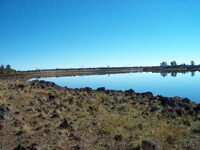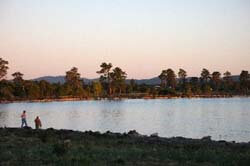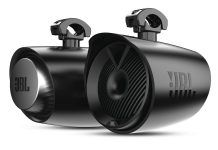Meeting The Challenge Of Rocky Lakes (Or Not)
By Kim Elridge

I’m heading off for a long weekend of camping, fishing, and geocaching today. One of my favorite lakes near Flagstaff is Ashurst Lake. Just looking at the lake, you can tell that it is a volcanic rock depression that was dammed to form the lake. (There are few natural lakes in Arizona.)
Typical shoreline for Ashurst: rocks, rocks, and more rocks! What that means is that the lakebed is full of jagged volcanic rocks that are only interested in one thing: snagging my tackle and dragging it to the watery depths, never to be seen again!
 Three Tips For Fishing Rocky Lakes
Three Tips For Fishing Rocky Lakes
Tip #1:
You know the feeling: Something just nibbled your bait and you want to make sure it’s still there. In a rocky lake, resist the urge to reel in slowly, thinking of course, that a trout can’t resist a moving target. What happens when you reel in slowly is that your weights and bait are on the lake bottom and can easily fall into the crevices between rocks and become trapped. If you reel in quickly and steadily, the weights and bait will rise above the lake bottom and minimize the chances to get snagged.
Tip #2:
Okay, it happened: your line is caught in something under the water and you want your tackle back! The first thing is to reel in any slack so your line is tight, but your pole isn’t bending.
Then, walk up the shore, keeping the tension on your line, while you jerk your line up and down. (When I say “jerk,” I mean using abrupt motions; I don’t mean trying to rip your tackle out of the water!) If that doesn’t work, try releasing the line and then reeling in again. And, the last part of the tip: With the line tight, hold your rod parallel to the ground and gently pull backwards. As soon as you feel the rocky lake bottom give up your tackle, follow Tip #1!
Tip #3:
There’s no avoiding it: You’re going to lose your bait and all your tackle; you just can’t get it unstuck. Well, believe it or not, there’s a right way to break your line. Instead of jerking and pulling on your line until it snaps, you’re going to have to cut it.
First, release the line and set your pole up on the shore where you’re not going to step on the tip. (I like to prop my pole against my chair — way out of the way and safe.)
Then, get as close to the water as you can, bend down and grab your line. (If you squat or kneel at the edge of the water, you’re less likely to fall in!)
Reaching out, pull your line towards you and, as close to the water as possible, cut the line. Be sure to check your line for fraying and signs of stress before putting any more tackle on.
Some great cutting tools are a pair of fingernail clippers, a pocket knife with scissors, or needle-nose pliers. Oh, you might also want to consider moving to a new bit of shore — if there’s a tackle-eating-snag down there, it will be after your new tackle for dessert to the first set it ate!































